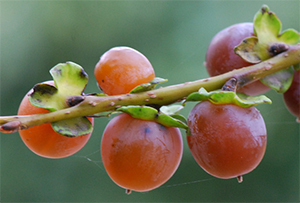Diospyros lotus


Other common names
Caucasian Persimmon.
Origin of the species name
Diospyros is from Greek words for 'divine' and 'wheat' referring to its edible fruit; lotus refers to it bearing fruit that induced dreaminess for the lotus-eaters in Homer's 'The Odyssey'.
Family
Ebenaceae
Date planted
May 2012
Lifespan
A long life span is expected.


General description
This is a small deciduous tree with grey-green bark. The large leaves are dark green and shiny and although deciduous in autumn do not change colour. The fruit are small and plumlike and become yellow or bluish black when they mature. Height 10m Spread 6m.
Natural distribution and habitat
The species is thought to be native to East Asia but may also have natural populations in Central and West Asia where it grows in mountain forests on rocky slopes.
Conservation status
It is not classified as a threatened species.
Planting pattern
Planted in straight lines which radiate out from the south-eastern edge.
Uses
Fruits are eaten fresh when very ripe or dried. Drying reduces the astringency if the fruits aren't fully ripe. The taste is half-way between a date and a plum, as the common name suggests. The fruits have also been used in folk medicine in Turkey as a treatment for constipation. The seedlings are sometimes used as a rootstock for Persimmon. The fine-grained, ebony-like wood polishes well and has been used for musical instruments, chess pieces, piano keys, construction and general carpentry.
